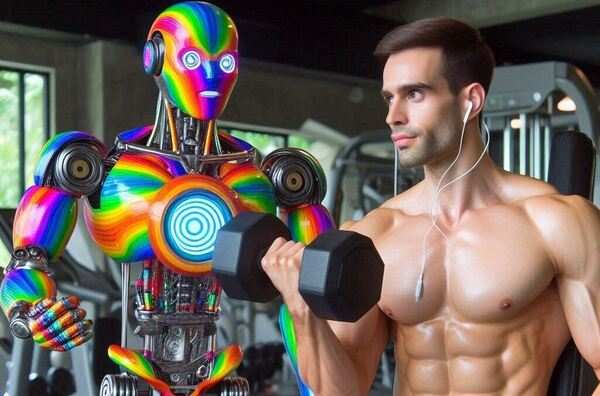Hey, ever thought about how machine learning has transformed the way we do things? It’s like this technology has seeped into everything, from the way we shop to how our devices predict what we’ll want next. But let's take a moment to consider something a little different—what if machine learning started exploring new territories, like queerness and identity? Picture AI learning as a quirky, creative twist that adds another layer to how machines learn, reflecting broader experiences and understanding the world in more diverse ways.
Let’s break down what this could look like in practice and explore how this playful spin could reshape not just technology, but how we think about identity and inclusion.

What Could "Machine Learning" Mean?
Okay, let’s first check out what this concept might even involve. "Machine learning" doesn’t mean that the machine itself has a sexual orientation, but rather that it could be trained to recognize, respect, and engage with the diversity of queer experiences. It’s about moving beyond the neutral or binary systems that dominate most AI frameworks today and allowing technology to reflect a broader spectrum of human experience.
Think about the possibilities:
Tailored algorithms: Just like we tailor machine learning models to predict behaviors or suggest content, imagine algorithms built with inclusivity in mind. These systems could acknowledge non-binary identities and break free from traditional gender norms that most current models use.
Data sets that reflect diversity: If machines are learning from diverse data sets that include queer experiences, their outputs would naturally become more inclusive. Think about a recommendation engine suggesting content that isn’t strictly heteronormative, but instead suggests a wider variety of LGBTQ+ content based on a more nuanced understanding of identity.
Interacting with identity fluidity: Instead of rigid, one-size-fits-all categories, AI learning could interpret identity in a fluid way. This would create systems that don’t box people into categories but reflect a wider range of human experiences, making them more relatable and relevant.
These possibilities open up an entirely new way of thinking about machine learning, moving it beyond cold algorithms and into a space where it reflects real-world diversity and fluidity.
Shaking Up Conventional Systems

Let’s face it, most machine learning systems today are built on traditional data structures that, more often than not, fail to acknowledge the complexity of human identity. Binary categories like male/female, yes/no, or even certain cultural assumptions are baked into the way these systems function. Machine learning could help shake up these conventional systems, adding layers that reflect more complex, inclusive human realities.
Consider these shifts:
- Breaking binary thinking: Machines today often rely on binary decisions—either/or options that don’t leave much room for flexibility. Imagine if machine learning systems were designed to think outside of binary terms, reflecting a broader understanding of identity that allows for more than just two options. It could involve everything from gender fluidity to recognizing a spectrum of preferences.
- Queering data structures: Data is often categorized in ways that reinforce traditional structures. Machine learning could introduce models that account for more ambiguous data inputs. Instead of forcing answers into neat categories, the system might learn to appreciate ambiguity.
- More inclusive customer experiences: As a result, businesses and services that use these systems would become more inclusive. Imagine a clothing brand whose recommendation engine suggests items without defaulting to rigid male/female categories, or dating apps that suggest matches based on nuanced identity markers rather than traditional gender labels.
This shift wouldn’t just make machine learning more inclusive, it could change how businesses and services think about their customers, too.
New Frontiers for Artificial Creativity

One thing that stands out with AI learning is how it could push artificial intelligence into more creative spaces. By training machines on diverse, queer experiences, you unlock new forms of expression and possibilities that might not fit into traditional molds.
Think about these areas:
- Art and media: Imagine an AI system creating art or media content that reflects a broader range of experiences, beyond the traditional binary narratives. Films, music, and even digital art could emerge that challenge existing norms and offer something fresh and unexpected.
- Fashion and design: Machines could start generating clothing designs that break away from the typical “men’s” and “women’s” categories. Instead, they could produce fashion that is truly inclusive and reflective of the fluidity in gender and identity.
- Storytelling: AI-powered systems could create narratives that don’t follow conventional paths, incorporating queer stories or character arcs in ways that feel authentic rather than tokenistic.
By broadening the input data to include a spectrum of identities and experiences, AI systems wouldn’t just mimic creativity—they’d evolve into something new, creating content that pushes boundaries in interesting and inclusive ways.
Moving Beyond Tokenism
One of the big issues in tech, especially when it comes to AI and machine learning, is that efforts toward inclusion often feel tokenistic. You’ll see AI tools that awkwardly try to account for diversity, but they don’t fully grasp the nuances involved. Machine learning offers an alternative path - one that doesn’t just tack diversity onto an existing system but builds it into the foundation.
Think about these differences:
- Inclusive by design: Instead of trying to retroactively add diversity to an algorithm, machine learning would build inclusivity right into the DNA of the system. From the data it learns from to the way it processes information, everything would be designed to reflect a diverse range of experiences from the start.
- Real representation: When machines are trained on data that reflects real, lived queer experiences, their outputs are more authentic. Rather than producing shallow representations of us pride LGBTQ+, these systems could generate content that feels real and representative of a broader experience.
- Non-normative outputs: One of the exciting things about machine learning is that it wouldn’t be restricted to producing outputs that fit into existing societal norms. Machines could generate content, make decisions, and create in ways that challenge traditional ideas and open up new possibilities.
In this way, machine learning isn’t about ticking a diversity box. It’s about fundamentally shifting how machines learn, reflect, and contribute to a broader, more inclusive world.
Reimagining the Human-Machine Relationship
Finally, one of the most interesting outcomes of machine learning is how it could reshape our relationship with technology itself. Right now, machines are often seen as neutral, utilitarian tools, but imagine if we started thinking about them as collaborators in exploring identity and expression.
These are some ways this could play out:
- Collaborative learning: Rather than machines just spitting out answers based on data, imagine a more dynamic exchange. As people engage with machine learning systems, the technology could evolve to better reflect the diversity and fluidity of human experience, creating a two-way street of learning.
- Machines as identity allies: Picture an AI system that actively supports queer identity formation, suggesting resources, offering connections, or creating content that helps users explore their identity in meaningful ways. This relationship would be more personal, more reflective of individual needs and experiences.
- Tech as a space for exploration: Technology could become a place where identity is explored, not just fixed or rigid. Machines could help people experiment with their identity, offering suggestions, paths, or even creative outlets that reflect queer experiences and ideas.
In this reimagined relationship, technology becomes more fabulous than ever - it’s a participant in the human experience, a partner in exploring and reflecting the vast diversity of human identity.
All in all, the idea of machine learning is a fun, imaginative twist on how machine learning might evolve. Instead of just focusing on optimization and efficiency, what if machines started learning from diverse human experiences, queer identities, and non-binary thinking? It opens up a whole new world of possibilities—one where technology isn’t just a neutral force but a creative, inclusive ally that reflects the full range of human experiences.
Did You Know You Already Have A LOT To Sell?
So What's Your Problem?


I wish I had hot robots like them…….not everyone listens the way I want them to. But eventually they come back.